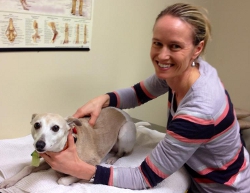As a non-surgical disease of the spinal cord, rehabilitation has a huge role to play in managing dogs diagnosed with FCE. Following diagnosis one of our animal physios will assess your dog and design a treatment plan unique for them. Maintenance of physical function and prevention of secondary compensatory changes is vital to your dog making good progress throughout the rehabilitation process. The level to which a patient is affected by the FCE will vary from dog to dog. Furthermore, the rate at which a patient progresses will dictate the necessary adjustments to the rehabilitation plan. Ongoing re-evaluation is essential to allow an effective and appropriate treatment course.
Physiotherapy aims:
In the initial stage following diagnosis, the aims are as follows:
- Maintain soft tissue flexibility
- Prevent muscle spasm
- Provide sensory stimulation
- Provide supported means of mobility
Depending on your dog’s progress, the aims might then progress to:
- Improving core stability
- Improving body awareness and coordination
- Providing home care management advice
6 weeks on from diagnosis your chartered physiotherapist would aim to:
- Strengthen core stability
- Improve gait pattern
- Increase cardiovascular fitness
- Return to normal functional activities
Physiotherapy options
Correct positioning, massage, and stretches can be implemented in the early days. Dry needling, heat therapy, and sensory stimulation techniques complement the healing at this stage. Muscle stimulation is invaluable to maintain “at-risk” muscle groups whilst your dog might be recumbent. As your dog improves, an appropriate exercise plan can be used to assist in gait re-education, strengthening, and promoting balance. In the latter stages, once your dog is recovering well, core stability exercises need advancing as does general cardiovascular fitness. Advice regarding assisting with everyday activities will be given for injury prevention.



